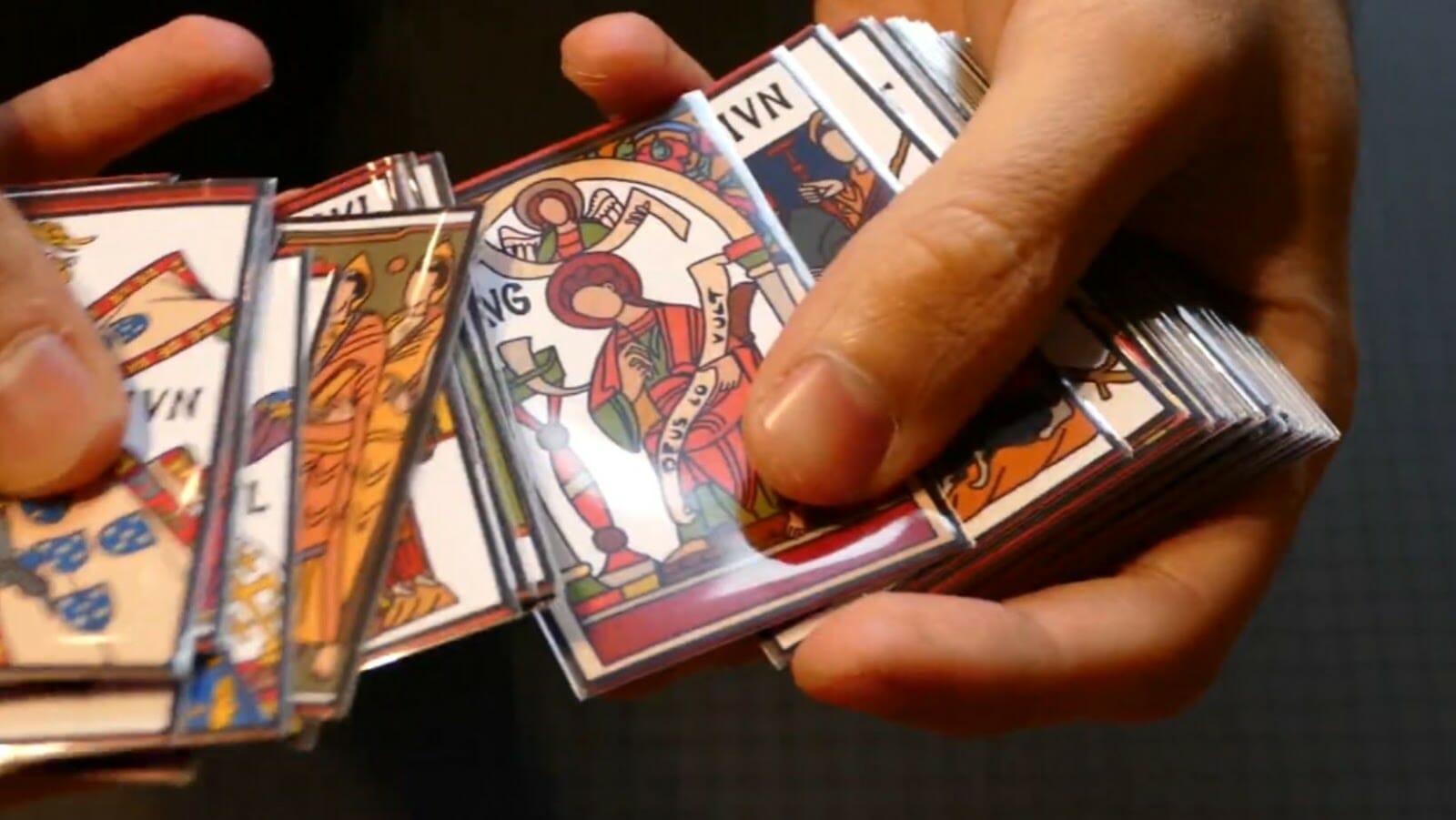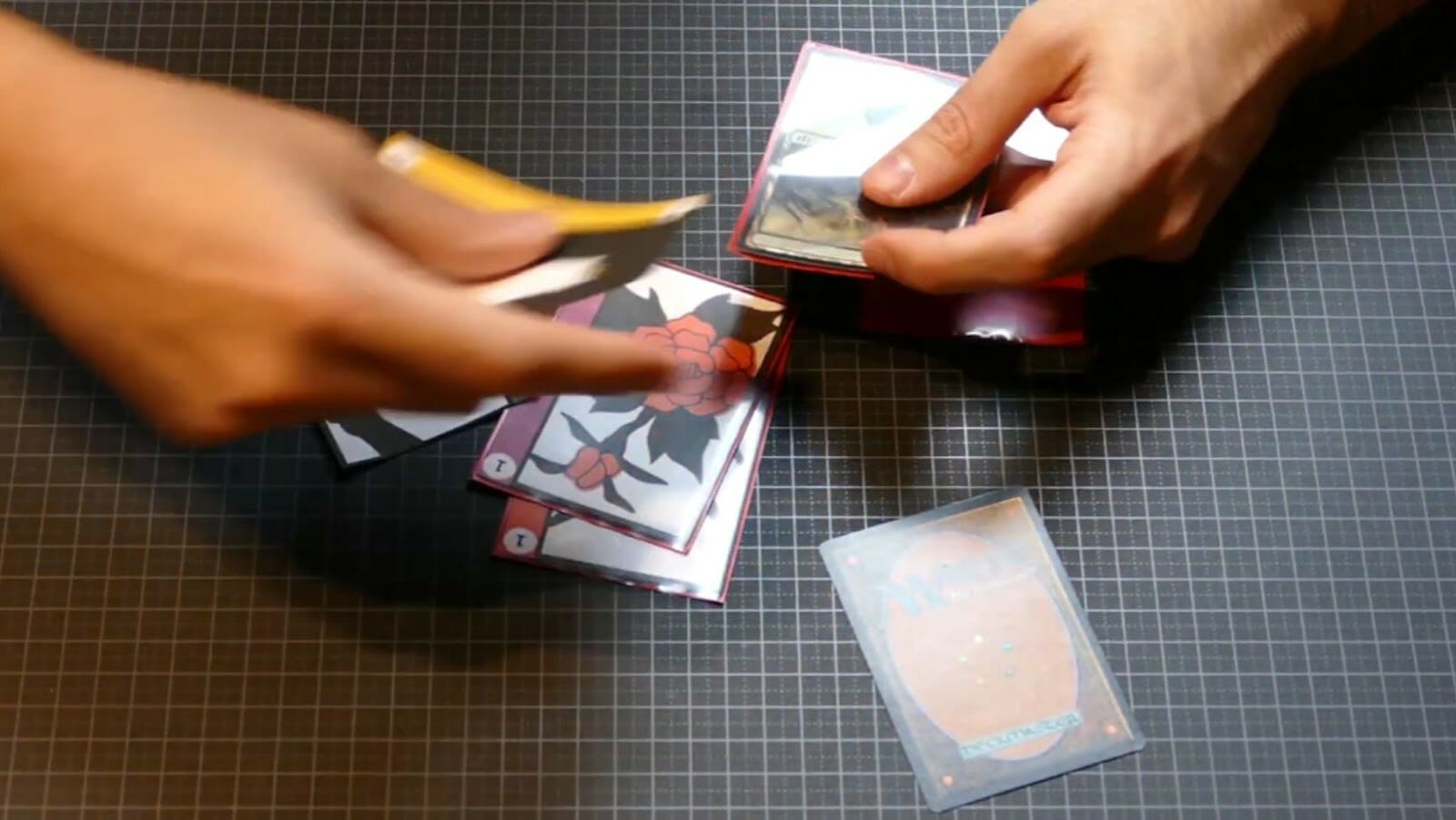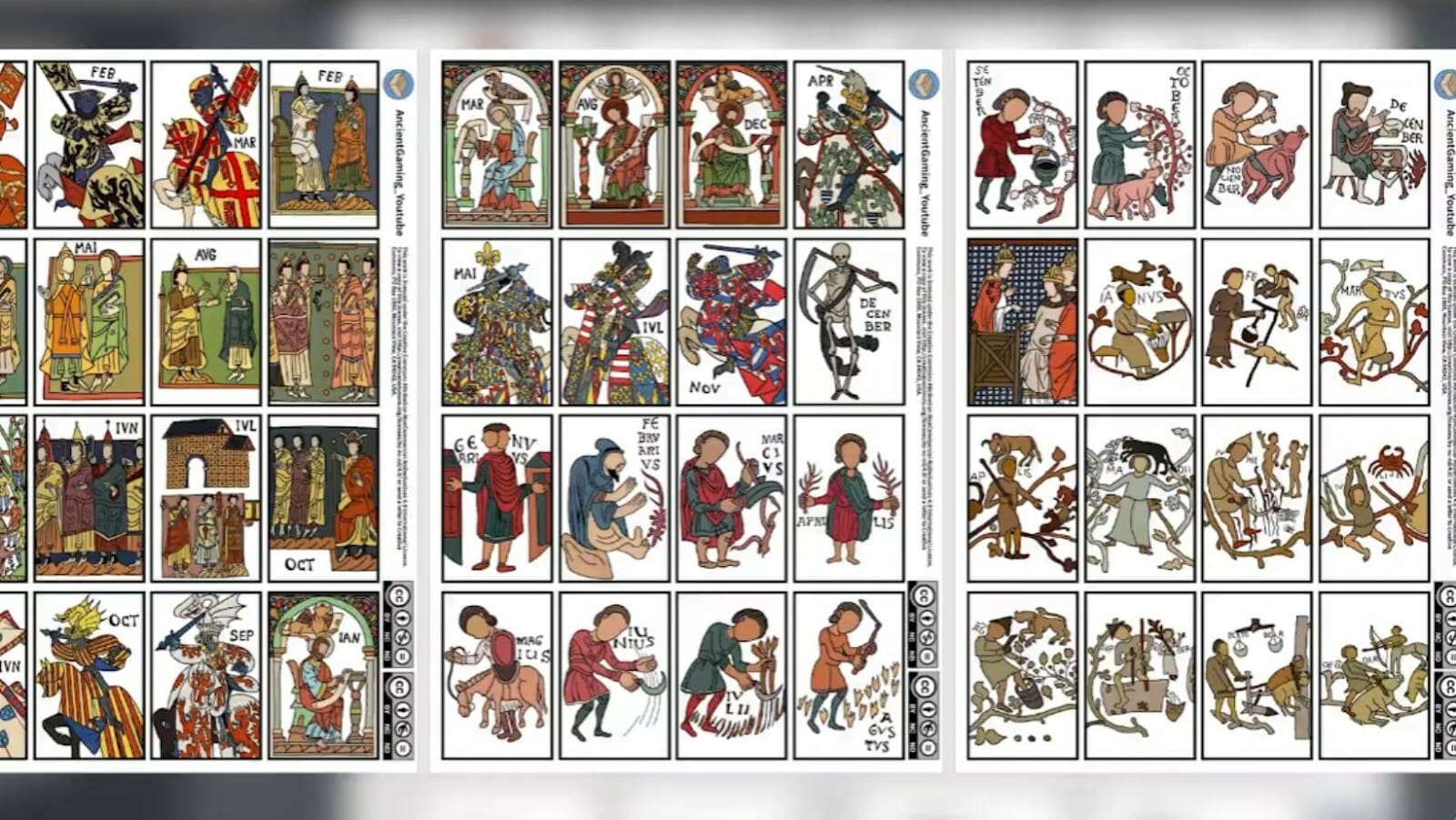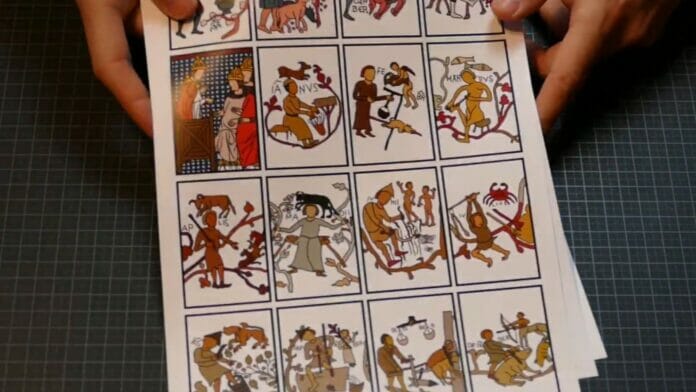Japanese playing cards have a long and storied history. As far back as the 16th century, these playing cards have been used for various activities, such as gambling and game playing.
There are many different types of Japanese playing cards, each with unique and interesting characteristics. Let’s explore the history of these cards and the types of cards that are available.
Bushocard/2742北条幻庵
Japanese playing cards or karuta date back to the 16th century, when Portuguese traders introduced playing cards to Japan.
The most common type of Japanese playing cards or karuta is the Hanafuda. The Hanafuda deck comprises 48 cards divided into 12 suits corresponding to each month of the year, each representing a flower. The cards are used to play various games, such as Koi koi and Hachi, and are often illustrated with traditional Japanese imagery, including animals and landscapes.
Another type of Japanese playing cards is the Kabufuda, which are often used for gambling games. The Kabufuda deck comprises 40 cards divided into four suits, each with ten cards. The cards are typically smaller and thicker than Hanafuda cards and have different symbols, including animals and Japanese numerals.
Lastly, there is a unique type of Japanese playing cards called Unsun Karuta used to play poetry games. The Unsun Karuta deck contains 200 cards, each featuring a poem on one side and a corresponding image on the other. The cards are used to play a game called uta-garuta, in which one person reads the first three lines of a poem and the players race to find and touch the corresponding card before their opponents.
Evolution of Japanese Playing Cards
The evolution of Japanese playing cards has been shaped by cultural influences from China and the West, resulting in several unique types of cards.
Hanafuda: Also known as “flower cards,” Hanafuda cards feature illustrations of flowers and plants that correspond to the 12 months of the year. Originally designed in the 16th century, this playing card is often used for traditional Japanese games such as Koi-Koi and Hachi-Hachi.
Kabufuda: Kabufuda cards feature illustrations of samurai, kabuki actors, and mythical creatures. Created for gambling purposes in the 18th century, Kabufuda cards are now mainly used to play Hanafuda games.
Mekuri Karuta: Mekuri Karuta cards have two sides, one with a picture and another with a corresponding poem. This card type plays traditional Japanese card games, including Uta-garuta and Hyakunin Isshu.
Western Playing Cards: Portuguese traders introduced Western playing cards to Japan in the 16th century. These cards, including the familiar hearts, diamonds, spades, and clubs, are now commonly used to play card games in Japan.
Cultural Significance of Japanese Playing Cards
Japanese playing cards or “Hanafuda” has been integral to Japanese culture since the 18th century. The cards feature beautiful illustrations of flowers and nature, each with a unique symbolism and meaning.
History of Japanese Playing Cards – Hanafuda
Hanafuda was created in the late 18th century to circumvent the gambling laws at that time. However, the cards quickly became popular and played in various social settings, from family gatherings to tea parties.
The Different Types of Japanese Playing Cards – Hanafuda
There are 12 different Hanafuda cards, each representing a month of the year and a specific flower or plant. The cards are divided into four categories:
- The Brights (Tanzaku)
- The Ribbons (Kasuri)
- The Animals (Inoshishi)
- The Chaff (Kohoh)
Each category has three or four cards, and the players must collect specific combinations of cards to win the game.
Pro Tip – If you’re interested in Japanese culture or a card game fan, try Hanafuda. It’s a fun and
unique way to experience Japanese traditions.

Bushocard/2930石田三成
Japanese playing cards, also known as Hanafuda, can offer a unique and intricate type of card playing that not many other countries have. In addition, they are distinct in their design and gameplay rules, offering many variations of the card game.
In this article, we’ll discuss the different types of Japanese playing cards available, how they are played, and how they differ from Western-style playing cards.
Hanafuda
Hanafuda is a traditional Japanese card game that has gained popularity worldwide. There are 12 different types of cards in a Hanafuda deck, each with its unique design and symbolisms.
Here are the different types of Japanese playing cards in a Hanafuda deck:
January (Matsu): Pine trees represent longevity, steadfastness, and the New Year.
February (Ume): Plum blossoms symbolize resilience, hope, and the end of winter.
March (Sakura): Cherry blossoms signify the arrival of spring, renewal, and rebirth.
April (Fuji): Wisteria flowers represent love, sensuality, and perseverance.
May (Ayame): Irises stand for courage, wisdom, and agility.
June (Botan): Peonies represent wealth, honor, and feminine beauty.
July (Hagi): Bush clovers signify autumn, serenity, and purification.
August (Susuki): Pampas grass symbolizes the moon, the harvest season, and regrowth.
September (Kiku): Chrysanthemums represent perfection, longevity, and rebirth.
October (Momiji): Japanese maples signify autumn, change, and transformation.
November (Yanagi): Willow branches represent resilience, flexibility, and renewal.
December (Kiri): Paulownia trees symbolize prosperity, abundance, and new beginnings.
Hanafuda Rules and Gameplay
Hanafuda is a traditional Japanese card game that has been popular for centuries, played with a deck of 48 cards divided into 12 suits. Each suit represents a different month of the year and is adorned with flowers and other symbols.
The gameplay and rules of Hanafuda are unique and require some getting used to. Players must match cards from their hand with cards on the table to create sets and win points.
Here are some basic rules to follow while playing Hanafuda:
- Each player takes turns drawing a card from the deck and discard it from their hand.
- Points are awarded for making specific sets and combinations, such as two or more cards of the same suit.
- The game ends when a predetermined number of rounds are completed, or one player reaches a set number of points.
Hanafuda is a game of strategy, skill and luck, that can take some time to learn but is ultimately rewarding and fun to play.
Hanafuda Deck Composition
Hanafuda cards are Japanese playing cards for games such as Koi-koi and Hachi-hachi. These cards are divided into twelve suits, representing the months of the year and each suit has four cards. Therefore, there are different compositions of Hanafuda deck depending on the regions in Japan.
Here are the two most common deck compositions:
1. Hana Awase: This deck is commonly used in Tokyo and Eastern Japan. It consists of 48 cards, with each month’s suit depicted with a unique flower and each card featuring an image from Japanese poetry or folk tales.
2. Kyo-karakusa: This deck is commonly used in Kyoto and Western Japan. It consists of 40 cards, with each month’s suit depicted through abstract vines and other foliage designs.
Both deck compositions have unique characteristics and are used for different games in Japan.

Karuta
Karuta is a traditional Japanese card game that utilizes several different types of cards. There are two main types of Karuta cards: Yomifuda and Torifuda.
Yomifuda, or “reading cards,” feature a poem or phrase written on them. In the game, a reader recites a poem from memory, and players race to find the matching Torifuda card.
Torifuda, or “grabbing cards,” feature an image or character corresponding to a poem or phrase on the Yomifuda card. Players compete to be the first to identify and grab the matching Torifuda card when the poem is read aloud.
There are several variations of Karuta, each with unique set of cards and rules. For example, the Hyakunin Isshu Karuta or “One Hundred Poets, One Poem Each” is a popular variant featuring 100 Yomifuda cards, each with a classical Japanese poem.
Karuta is a beloved pastime for many in Japan and is known for its educational and cultural significance in teaching history, poetry, and language.
Karuta Rules and Gameplay
Karuta is a traditional Japanese card game that involves speed, memory, and quick reflexes. Here are some of the basic rules and gameplay of the game:
The game is typically played with two sets of cards – yomifuda, the reader cards, and torifuda, the player cards.
The yomifuda contains a poem read aloud by a reader, while the players race to find the matching card from their set of torifuda.
The player who first touches the correct card with their hand and removes it from play earns a point.
The game continues until all the cards have been matched and removed from play, with the player with the most points at the end declared the winner.
There are several variations of the game, including uta-garuta, which uses classical Japanese poetry for the poems on the cards, and iroha-garuta, which uses a famous Japanese poem called the Iroha for its cards.
Types of Karuta Cards
Karuta is a traditional Japanese card game that has been played for centuries. There are two main types of Karuta cards: Yomifuda and Torifuda.
Yomifuda: Yomifuda are the reading cards that contain a poem’s first three lines or a phrase from a story. The reader (or parent) uses these cards during the gameplay to recite the poem or the phrase.
Torifuda: Torifuda are the playing cards, also known as grabbing cards, that contain an image or the last two lines of the poem on the corresponding Yomifuda card. Players need to identify and grab the relevant Torifuda card as quickly as possible when the reader recites the poem or the phrase.
Different types of Karuta cards such as uta-garuta or “poem Karuta,” feature traditional Japanese poems. Hyakunin isshu karuta or “one hundred people, one poem Karuta” is another popular Karuta variant in which one hundred different poems are featured.
Kabufuda
Kabufuda is one of the three Japanese playing cards, each with unique characteristics and cultural significance. Here’s a brief overview:
Hanafuda: Hanafuda cards feature floral designs traditionally used for games like Koi-Koi and Hachi-Hachi. Each deck has 48 cards, divided into 12 suits of 4 cards each.
Karuta: Karuta cards are rectangular and used for physical games that involve grabbing or slapping the cards. There are two main types of Karuta cards: yomifuda and torifuda.
Kabufuda: Kabufuda cards are smaller and have a thicker texture than other Japanese playing cards. They come in various designs and are used for gambling and other games of chance. There are 40 cards in a Kabufuda deck, divided into four suits of 10 cards each.
These traditional Japanese playing cards have a unique history and place in Japanese culture, making them a fascinating aspect of the country’s gaming traditions.
Kabufuda Rules and Gameplay
Kabufuda is a traditional Japanese gambling game played with a unique set of kabufuda cards. Here are the rules and gameplay of Kabufuda:
Kabufuda cards have a variety of designs, including birds, flowers, and numbers, and are smaller in size than Western playing cards.
The game is played with two or more players and uses 40 cards, shuffled and dealt evenly among the players.
Each player takes turns to place a card on the table, creating a pile of cards.
The game’s goal is to capture cards by matching the design or number of your card with the card on the table.
Jokers and extra cards can also be added to the game for additional rules and challenges.
Pro Tip: Kabufuda is a fascinating card game many Japanese players enjoy. If you’re interested in learning more about traditional Japanese gambling games, Kabufuda is an excellent place to start.
Difference Between Kabufuda and Hanafuda
Kabufuda and Hanafuda are two traditional Japanese playing cards with significant differences.
Kabufuda is a type of Japanese playing cards that originated in the Edo period. It consists of 40 cards that are smaller in size compared to Hanafuda. The cards have intricate designs representing ancient Japanese cultural motifs such as cranes, maple leaves, and chrysanthemums.
Hanafuda, on the other hand, is a more popular type of Japanese playing cards that consists of 48 cards divided into 12 suits. The suits of Hanafuda are represented by different kinds of flowers and plants such as cherry blossoms, irises, and willows. These cards are often used to play traditional Japanese games like Koi-Koi and Hachi-Hachi.
Understanding the difference between these Japanese playing cards can help enthusiasts and collectors add variety to their collection and playtime.

Bushocard/2036朝倉義景
Based on the Hanafuda system, Japanese playing cards were first introduced to Japan in the late 19th century. Since then, they have become established throughout Japanese culture, with various playing cards used for various games.
In modern times, Japanese playing cards have become increasingly popular and have even entered the international market. Let’s explore the different types of Japanese playing cards available and their uses.
The Popularity of Japanese Playing Cards
Japanese playing cards or Hanafuda cards have been popular in Japan for centuries and are an integral part of Japanese culture. There are several Hanafuda cards, each with a unique design and gameplay.
The most popular type is the traditional 48-card set, featuring 12 suits representing the months of the year and different flora and fauna associated with them. This set is typically used for traditional Japanese games like Koi-koi and Hachi-hachi.
Another type is the 40-card set, originally designed for Western-style games like poker and blackjack but is now used for Japanese games. This set has simplified designs, using only numbers and symbols.
The third type is the Echigo Karuta, a regional variation popular in the Niigata prefecture with characters from the Ogura Hyakunin Isshu anthology. This variation is used for the competitive game Karuta and requires players to listen to a poem and identify the correct card.
With their unique artistry and gameplay, Hanafuda cards have become an iconic symbol of Japanese culture, making them a must-have for card game enthusiasts and collectors alike.
Bushocard/1008浅井長政
Japanese playing cards, also known as Hanafuda cards, are popular in modern Japanese culture and entertainment. There are 12 suits in Hanafuda, each representing a month of the year and featuring different plant or animal motifs.
Here are the different types of Japanese playing cards:
January: Matsu (pine tree)
February: Ume (plum blossom)
March: Sakura (cherry blossom)
April: Fuji (wisteria)
May: Ayame (iris)
June: Botan (peony)
July: Hagi (bush clover)
August: Susuki (pampas grass)
September: Kiku (chrysanthemum)
October: Momiji (maple leaf)
November: Yanagi (willow)
December: Kiri (paulownia tree)
Today, Hanafuda cards are used in various games, including the popular Japanese game Koi-Koi. They have also appeared in manga, anime, and movies, showcasing their importance in Japanese media and entertainment.
Bushocard/3172陶晴賢
Japanese playing cards, known as “Hanafuda” or “flower cards,” have been an integral part of Japanese traditional culture since the 18th century. There are three types of Japanese playing cards, each with their own unique characteristics and game variations.
The three types of Japanese playing cards include:
Hanafuda: The most popular type of Japanese playing card, Hanafuda cards are small and intricately designed, featuring 12 suits that represent different plants and flowers.
Kabufuda: This type of Japanese playing card is similar to Hanafuda but has a simplified design and fewer suits.
Mekuri Karuta: Also known as “changing cards,” Mekuri Karuta is a unique variant of Japanese playing cards. It features one deck of cards dealt face-down, and players must try to collect cards by guessing their opponent’s card based on a clue.
Japanese playing cards are still widely popular today and are an excellent way to learn about Japan’s rich history and culture.


